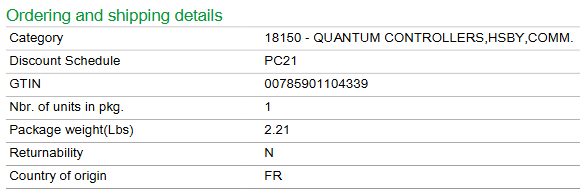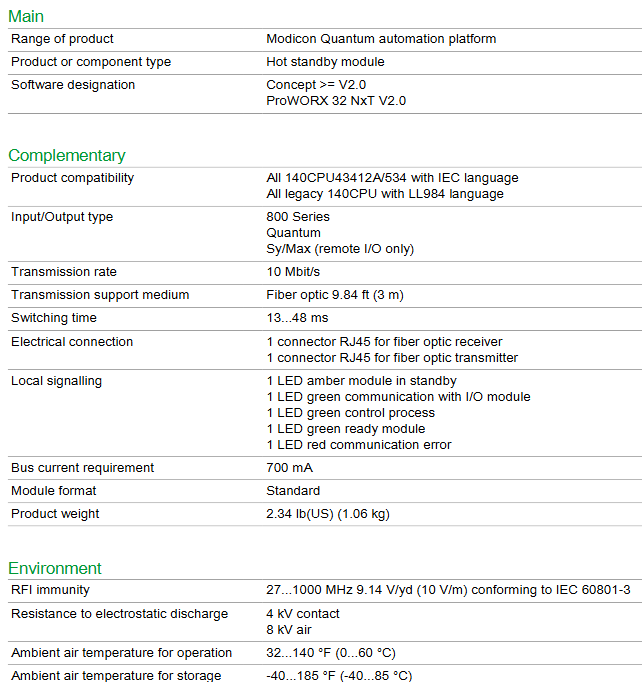Schneider Electric 140CHS 1100 Communication Module
Schneider Electric 140CHS 1100 Communication Module
140CHS 1100 is the core communication module of Schneider Electric's Modicon Quantum series PLC, mainly used to connect Quantum controllers with industrial Ethernet networks. It supports mainstream industrial communication protocols such as Modbus TCP/IP, has high stability, flexible expansion, and redundant communication capabilities, and is suitable for the needs of equipment networking, data exchange, and remote monitoring in industrial automation, process control, and other scenarios. It is a key component in building Ethernet communication architecture for Quantum systems.
Basic Information and Product Positioning
1. Core identification and ownership
Product model: 140CHS 1100 (unique ordering and hardware identification code)
Product series: Modicon Quantum (Schneider's high-end PLC product line, aimed at large-scale industrial control scenarios)
Function positioning: Ethernet communication interface module, as the "network gateway" of Quantum controller, realizing the connection between the controller and the upper computer (such as SCADA system HMI)、 Ethernet data exchange for other PLCs or industrial equipment.
Substitution and Compatibility: There is no direct substitute model, compatible with the full range of Modicon Quantum controllers (such as 140CPU65150, 140CPU67160), and supports collaboration with other modules in the Quantum series (such as I/O modules, specialized functional modules).
2. Core values
Protocol standardization: Native support for Modbus TCP/IP protocol, compatible with industrial Ethernet universal standards, no additional protocol conversion required, reducing system integration complexity.
Communication stability: Adopting industrial grade hardware design, it can withstand electromagnetic interference and environmental fluctuations in industrial sites, ensuring long-term continuous communication without interruption.
Redundancy Support: Supports dual module redundancy configuration (in conjunction with Quantum system redundancy function), automatically switches in case of failure, improves communication link reliability, and is suitable for critical control scenarios such as petrochemicals and power dispatch.
Hardware specifications and electrical characteristics
1. Physical and interface specifications
Size and Installation:
Dimensions: Complies with the Quantum series standard module dimensions (height 130mm x width 36mm x depth 110mm, specific subject to physical object), adopts rail installation, compatible with Quantum standard rack (such as 140XTS00200 rack), occupies one module slot.
Weight: Approximately 0.3kg (excluding accessories), lightweight design does not increase rack load.
Communication interface:
Ethernet port: 1 RJ45 interface, supports 10/100Mbps adaptive speed, compatible with full duplex/half duplex modes, supports Auto MDI/MDI-X automatic line sequence adjustment (no need to distinguish between crossover and straight through lines), convenient for on-site wiring.
Status indicator lights: 2 LED indicator lights (Link/Activity light: green, constantly on indicates link connectivity, flashing indicates data transmission; Fault light: red, constantly on indicates module failure, off indicates normal), visually judging the communication and module status.
2. Electrical parameters
Power supply demand:
Power input: Powered from the Quantum rack backplane, supports DC 5V (typical current 1.2A, maximum current 1.5A), does not require external independent power supply, simplifies wiring.
Power consumption: Typical power consumption is 6W, maximum power consumption is 7.5W, low-power design reduces the overall power load of the rack.
Electromagnetic compatibility (EMC):
Compliant with EN 61000-6-2 (industrial environment immunity) and EN 61000-6-4 (industrial environment emission) standards, it can withstand electrostatic discharge (ESD) ± 8kV (contact discharge) and ± 15kV (air discharge), and has a radio frequency radiation immunity of 10V/m (80-1000MHz), suitable for strong industrial interference environments.
Environmental adaptability:
Working temperature: 0 ° C~60 ° C (non condensing), storage temperature: -40 ° C~85 ° C, suitable for high and low temperature fluctuations in industrial sites.
Humidity: 5%~95% relative humidity (no condensation), resistant to humid environments, no additional moisture-proof measures required.
Communication functions and protocol characteristics
1. Core communication protocol
Modbus TCP/IP:
Role support: Can serve as a Modbus TCP server or client. In server mode, it supports up to 32 concurrent client connections (such as 32 HMIs accessing simultaneously). In client mode, it can actively access other Modbus TCP servers (such as reading remote PLC data).
Data Interaction: Supports Modbus standard function codes (such as 03H read hold register, 06H write single register, 10H write multiple registers), with a maximum data length of 125 registers (16 bits per register), meeting the requirements of batch data transmission in industrial control.
Communication efficiency: At a speed of 100Mbps, the response time of a single Modbus command is ≤ 10ms (within the local area network), ensuring real-time control requirements (such as millisecond level data acquisition and command issuance).
2. Network and scalability
Network configuration:
Support static IP address configuration (set through Quantum programming software Unity Pro), or automatically obtain IP addresses through DHCP, adapting to different network management modes.
Support subnet mask and gateway settings, enable cross network communication (such as connecting enterprise level LAN and on-site control network), and meet the multi area networking needs of large factories.
Extended features:
Support "Peer to Peer" communication between Quantum controllers through Ethernet, without the need for a host computer to transfer data and directly exchange data (such as collaborative control of multiple controllers in a production line).
Compatible with Schneider SoMachine/Unity Pro programming software, module parameter configuration, communication diagnosis, and firmware upgrade can be achieved through software, simplifying operation and maintenance.
Configuration and Operations
1. Configuration tools and processes
Core tools: Schneider Unity Pro programming software (V11 and above, compatible with Windows 10/11 system) or SoMachine software (suitable for later system upgrades) is required.
Configuration steps:
Hardware configuration: Add Quantum controller and 140CHS 1100 module to the software, and specify the slot position of the module in the rack.
Network parameter settings: Configure module IP address, subnet mask, gateway, select Modbus TCP role (Server/Client), and set the upper limit of server connections.
Data Mapping: Map the internal registers of the controller (such as the% MW hold register) to Modbus TCP register addresses, clarifying the correspondence between the data accessed by the upper computer.
Download and Activation: Download the configuration file to the Quantum controller, and the module will automatically load the configuration and start communication. Confirm the status through the LED indicator light.
2. Diagnosis and maintenance
Fault diagnosis:
Software diagnosis: Through the "diagnosis" function of Unity Pro software, view module communication logs (such as connection establishment/disconnection records, instruction timeout records), error codes (such as IP address conflict codes, communication timeout codes), and quickly locate the cause of the fault.
Hardware diagnosis: When the Fault light is constantly on, the module fault information (such as power failure, port failure) can be read through the rack backplane diagnostic interface, or the module can be replaced for testing (compatible with hot plugging, "hot plugging enable" needs to be set in Unity Pro).
Firmware upgrade: Supports online firmware upgrade via Ethernet (requires downloading the latest firmware file from Schneider's official website), without affecting the normal operation of the controller during the upgrade process (ensuring network stability during the upgrade process), improving module functionality and compatibility.

Application scenarios and compatibility
1. Typical application scenarios
Industrial automation production line: As the Ethernet interface of Quantum controller, it connects to HMI (such as Schneider Magelis HMI) to achieve production line status monitoring and parameter setting, and also connects to SCADA system (such as Schneider Citect SCADA) to achieve data acquisition and scheduling throughout the plant.
In the field of process control, in scenarios such as petrochemicals and water treatment, achieve Ethernet communication between Quantum controllers and remote I/O modules (such as Schneider EcoStruxure Control Expert compatible modules), intelligent instruments (such as flow meters and level gauges), and transmit process data and control commands.
Redundant communication architecture: In key scenarios such as power and metallurgy, two 140CHS 1100 modules are configured to achieve communication redundancy. When the main module fails, the backup module automatically takes over communication to ensure uninterrupted transmission of control instructions and data.
2. Compatibility Description
Hardware compatibility: Only compatible with Modbus Quantum series racks and controllers, not compatible with other series of PLCs such as Modbus M340, M580, etc. Please confirm the system hardware ownership before selecting.
Software compatibility: Requires Unity Pro V11 or above, or SoMachine V4 or above. Low version software may not support some configuration features (such as DHCP automatic IP acquisition).
Third party device compatibility: Supports communication with third-party devices that comply with the Modbus TCP/IP standard (such as Siemens S7-1200/1500 PLC, Rockwell ControlLogix controller). By configuring Modbus TCP client/server parameters in the third-party device, cross brand data exchange can be achieved.
Ordering and spare parts information
1. Order model and accessories
Core module: 140CHS 1100 (standard model, no derivative version, no additional parameters need to be specified when ordering).
Common accessories:
Ethernet cable: CAT5e or CAT6 shielded cable (shielded cable is recommended to reduce interference), the length is selected according to the on-site wiring requirements (maximum transmission distance of 100m).
Module dust cover: Schneider specific dust cover (model to be consulted with the manufacturer), used to protect interfaces and slots when the module is not installed.
Rack: Quantum standard rack (such as 140XTS00200, 2-slot rack; 140XTS00600, 6-slot rack), the number of rack slots should be selected based on the number of modules.
2. Warranty and Support
Warranty period: The original factory standard warranty is 18 months (calculated from the delivery date), and can be extended to 3 years through registration on Schneider's official website (product serial number and purchase certificate are required).
Technical support: Configuration guides and troubleshooting manuals can be obtained through Schneider's global technical support hotline (such as 400-810-1315 in China), the official website's technical documentation center, or by contacting local agents for on-site technical services.

- EMERSON
- Honeywell
- CTI
- Rolls-Royce
- General Electric
- Woodward
- Yaskawa
- xYCOM
- Motorola
- Siemens
- Rockwell
- ABB
- B&R
- HIMA
- Construction site
- electricity
- Automobile market
- PLC
- DCS
- Motor drivers
- VSD
- Implications
- cement
- CO2
- CEM
- methane
- Artificial intelligence
- Titanic
- Solar energy
- Hydrogen fuel cell
- Hydrogen and fuel cells
- Hydrogen and oxygen fuel cells
- tyre
- Chemical fiber
- dynamo
- corpuscle
- Pulp and paper
- printing
- fossil
- FANUC
- Food and beverage
- Life science
- Sewage treatment
- Personal care
- electricity
- boats
- infrastructure
- Automobile industry
- metallurgy
- Nuclear power generation
- Geothermal power generation
- Water and wastewater
- Infrastructure construction
- Mine hazard
- steel
- papermaking
- Natural gas industry
- Infrastructure construction
- Power and energy
- Rubber and plastic
- Renewable energy
- pharmacy
- mining
- Plastic industry
- Schneider
- Kongsberg
- NI
- Wind energy
- International petroleum
- International new energy network
- gas
- WATLOW
- ProSoft
- SEW
- wind
- ADVANCED
- Reliance
- YOKOGAWA
- TRICONEX
- FOXBORO
- METSO
- MAN
- Advantest
- ADVANCED
- ALSTOM
- Control Wave
- AB
- AMAT
- STUDER
- KONGSBERG
- MOTOROLA
- DANAHER MOTION
- Bently
- Galil
- EATON
- MOLEX
- Triconex
- DEIF
- B&W
- ZYGO
- Aerotech
- DANFOSS
- KOLLMORGEN
- Beijer
- Endress+Hauser
- MOOG
- KB
- Moxa
- Rexroth


Email:wang@kongjiangauto.com
























































































































